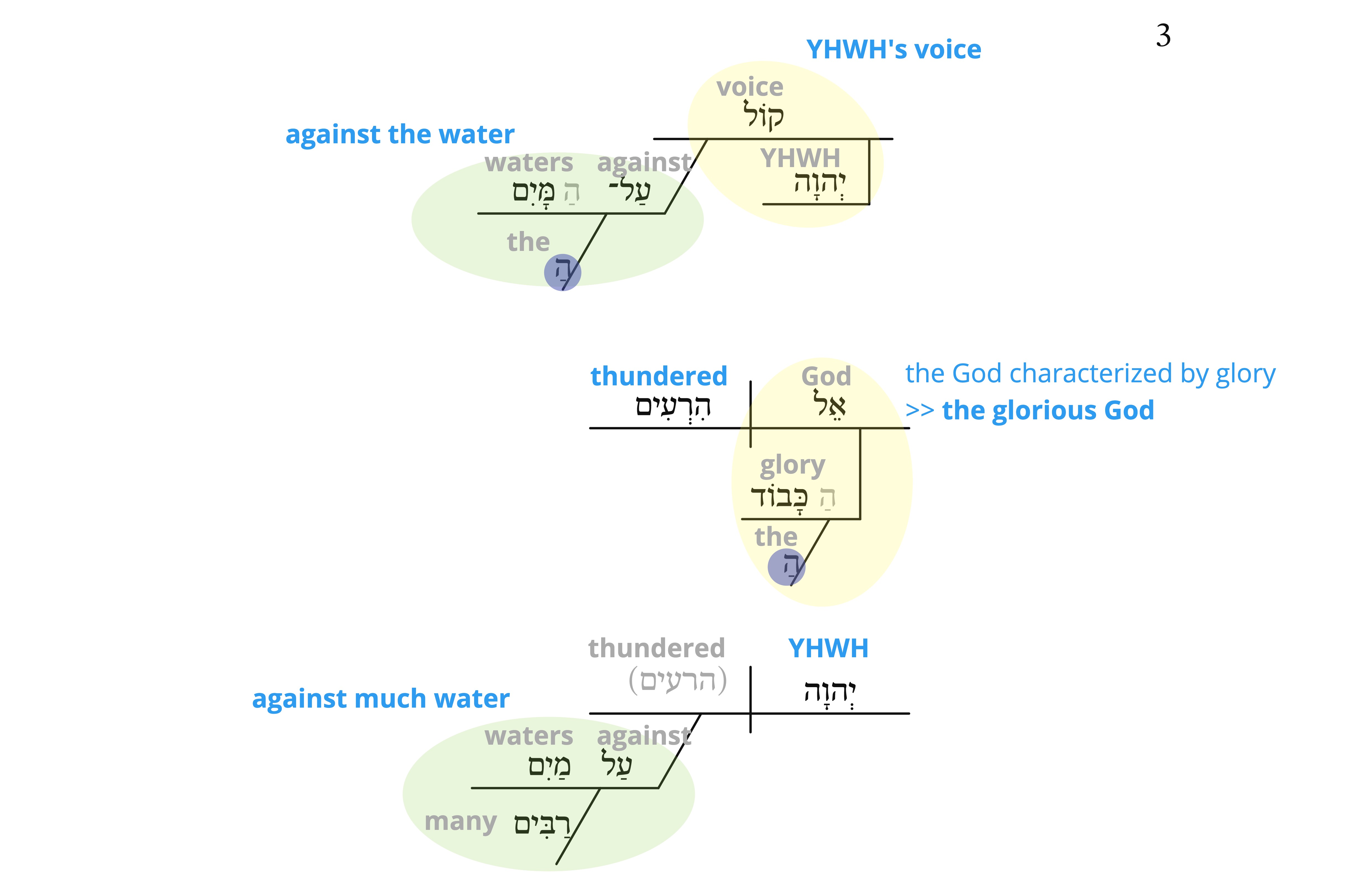Close-but-Clear
- Grammar
- Semantics
- Exegetical Issues
- Discourse
- Poetics
- Synthesis
- Close-but-Clear
- Videos
- Post to wiki
Overseer: Amanda Jarus
Introduction
The Close-but-clear translation (CBC) exists to provide a window into the Hebrew text according to how we understand its syntax and word-to-phrase-level semantics. It is not intended to be used as a stand-alone translation or base text, but as a supplement to Layer-by-Layer materials to help users make full use of these resources.
Steps
1. Gather glosses from phrase-level semantics.
View the phrase-level semantics diagram and use the word/phrase glosses (bold-blue text) to begin forming the CBC translation.
For example, the phrase-level diagram for Psalm 29:3 is as follows:

Putting the glosses together to form sentences (or sentence fragments, depending on the Hebrew grammar), results in the following:
- YHWH's voice against the water!
- The glorious God thundered.
- YHWH against much water.
This forms the base of the CBC. After completing this initial step, some clauses may be considered complete. Other clauses will need to be further modified.
2. Modify as necessary.
Fill in gaps in the translation as necessary. For example, you may need to add elements that are elided in the grammatical diagram. Use square brackets for grammatically elided words. For example, Psalm 29:3c "YHWH against much water" should become "YHWH [thundered] against much water." Other modifications may be necessary where the resulting English text is incoherent or misleading. Such modifications/additions do not need to be marked with brackets.
3. Add punctuation.
Add proper punctuation. Follow the conventions included in "Conventions for Close-but-clear" below.
4. Post to the forum.
Post your CBC to the forum (the CBC category) for review. Give it the title "Close-but-Clear - Ps 000" and make sure the page is tagged with the appropriate psalm number. At the top of this page, include the Hebrew text (making sure you use the text from the open source Hebrew Bible), updating it to include any preferred emendations or revocalizations. Important note: This forum CBC becomes the master version of the CBC for the psalm during the analysis process. All CBC materials on the Miro board should be consistent with the forum master version.
Appendix
CBC Conventions
Spelling
As with all Scriptura materials, follow US English spelling conventions.
Capitalization
Follow standard English conventions. This includes the following:
- Do not capitalize pronouns referring to God. (Any ambiguity regarding participant reference should be dealt with in Participant Analysis.)
- Do not capitalize terms such as “god,” “lord,” or “king” unless used as a name or direct title of God. Examples: In Ps 8, “YHWH, our lord” not “YHWH, our Lord;” In Ps 10:16, “YHWH is king forever,” not “YHWH is King forever.”
Vocatives
Follow standard English conventions. This includes the following:
- Offset vocative with commas.
- Do not add “O” to the vocative (e.g. "Lord" not "O Lord").
- Do not add "you" to the vocative (e.g. Ps 2:10a "And now, kings, be wise" not "And now, you kings, be wise").
Punctuation
In general, follow standard English conventions.
- Modals: As a default, volitive modals (imperatives, jussives, and cohortatives) should be punctuated with exclamation marks (as opposed to full stops). Use of full stops may be warranted upon consideration of other factors (e.g. clause length, emotional content).
- Sentence fragments: Sentence fragments may be punctuated with exclamation marks. For example, Psalm 29:3a (a sentence fragment) is an exclamation. It might be punctuated with an exclamation mark: "YHWH's voice against the water!"
- Synonymous poetic lines: Use semicolons between synonymous poetic cola.
Tetragrammaton
Write as YHWH (when reading in oral materials, read as "Lord").
Transliteration
Follow SBL simple version.
Parentheses and Brackets
The use of parentheses should generally be avoided. English uses brackets, not parentheses, to denote additions to a text by an editor or translator.[1] Parentheses, on the other hand, are used by the original author to set information off from the surrounding text, often to add information or explain.[2]
As such, parentheses should not be used in the CBC, unless they enclose information that the Hebrew author intended to be parenthetical. The expanded paraphrase (in Story Behind) will allow you to expand the translation to include assumptions and other background ideas. The CBC by itself should be rather conservative. Unlike the expanded paraphrase, it should not use parentheses to indicate implied information.
Place any words that are elided in the grammatical diagram in square brackets (e.g., "YHWH [thundered] against much water" in Ps 29:3).
Rubric
| Dimension | Description |
|---|---|
| Completeness |
|
| Quality |
|
| Clarity of Language |
|
| Formatting/Style |
|
Submitting your draft
Copy the text below into your forum submission post, entitled CBC - Psalm ###. After posting, change your post into a wiki post so the reviewers can check the boxes. To change your forum post into a wiki post, click on the three-dot menu at the end of the text.
Click on the wrench.
Select "make wiki."
[Close-but-Clear Layer Rubric](https://psalms.scriptura.org/w/Close-but-Clear#Rubric) |Guardian Review|Overseer Review|Final Checks|Description| | --- | --- | --- | --- | ||||**Completeness** |[ ]||| All Hebrew text is translated into English. ||||**Quality** |[ ]|[ ]|[ ]| CBC and phrase-level diagram glosses match. |[ ]|[ ]|[ ]| CBC text aligns with the meaning of the Hebrew grammar as diagrammed. |[ ]|[ ]|[ ]| CBC aligns with the current verbal semantic analysis. |[ ]|[ ]|[ ]| Line breaks in the CBC align with the current poetic line divisions. ||||**Clarity of language** |[ ]|[ ]|[ ]| Proper English grammar and natural word order are used, as natural as possible while still close to the Hebrew. |[ ]|[ ]|[ ]| The meaning of the text is clear. ||||**Formatting/Style** |[ ]|[ ]|| Proper punctuation is used, following the [https://psalms.scriptura.org/w/Close-but-Clear#Appendix CBC conventions]. |[ ]|[ ]|| Elided text is in square brackets. |[ ]||| Hebrew text in forum post represents the preferred text, including preferred emendations and revocalizations.